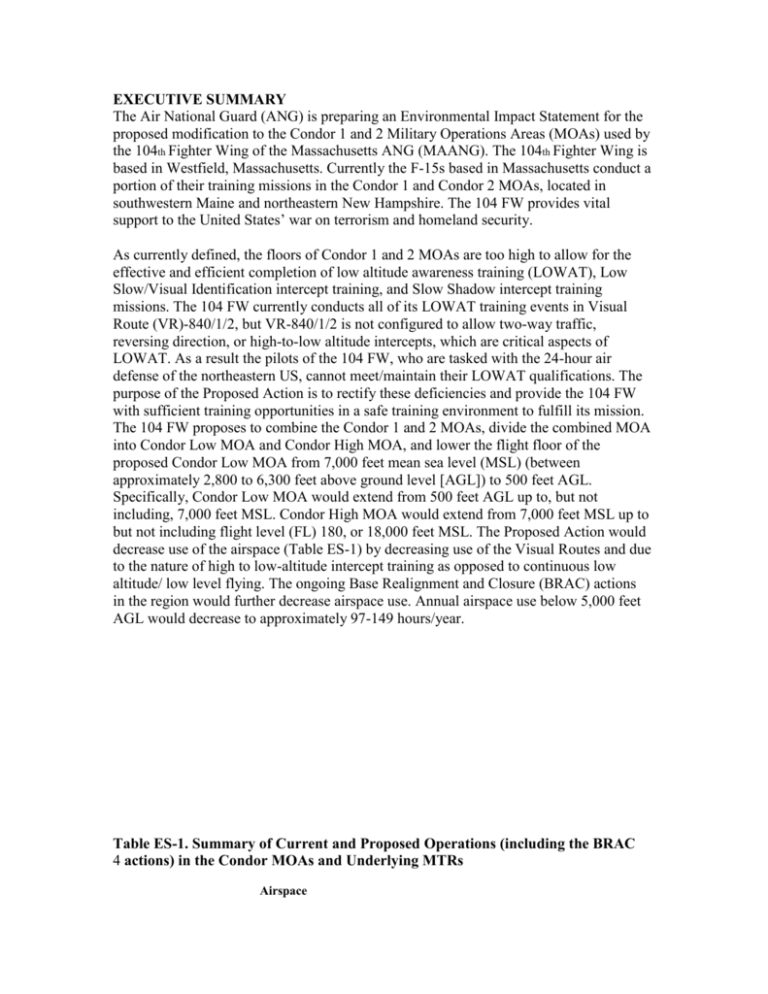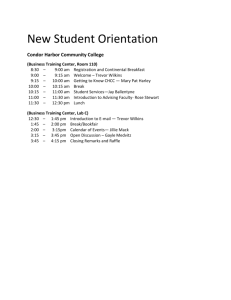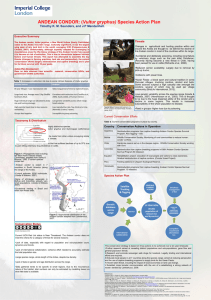Executive Summary Draft EIS Condor
advertisement

EXECUTIVE SUMMARY The Air National Guard (ANG) is preparing an Environmental Impact Statement for the proposed modification to the Condor 1 and 2 Military Operations Areas (MOAs) used by the 104th Fighter Wing of the Massachusetts ANG (MAANG). The 104th Fighter Wing is based in Westfield, Massachusetts. Currently the F-15s based in Massachusetts conduct a portion of their training missions in the Condor 1 and Condor 2 MOAs, located in southwestern Maine and northeastern New Hampshire. The 104 FW provides vital support to the United States’ war on terrorism and homeland security. As currently defined, the floors of Condor 1 and 2 MOAs are too high to allow for the effective and efficient completion of low altitude awareness training (LOWAT), Low Slow/Visual Identification intercept training, and Slow Shadow intercept training missions. The 104 FW currently conducts all of its LOWAT training events in Visual Route (VR)-840/1/2, but VR-840/1/2 is not configured to allow two-way traffic, reversing direction, or high-to-low altitude intercepts, which are critical aspects of LOWAT. As a result the pilots of the 104 FW, who are tasked with the 24-hour air defense of the northeastern US, cannot meet/maintain their LOWAT qualifications. The purpose of the Proposed Action is to rectify these deficiencies and provide the 104 FW with sufficient training opportunities in a safe training environment to fulfill its mission. The 104 FW proposes to combine the Condor 1 and 2 MOAs, divide the combined MOA into Condor Low MOA and Condor High MOA, and lower the flight floor of the proposed Condor Low MOA from 7,000 feet mean sea level (MSL) (between approximately 2,800 to 6,300 feet above ground level [AGL]) to 500 feet AGL. Specifically, Condor Low MOA would extend from 500 feet AGL up to, but not including, 7,000 feet MSL. Condor High MOA would extend from 7,000 feet MSL up to but not including flight level (FL) 180, or 18,000 feet MSL. The Proposed Action would decrease use of the airspace (Table ES-1) by decreasing use of the Visual Routes and due to the nature of high to low-altitude intercept training as opposed to continuous low altitude/ low level flying. The ongoing Base Realignment and Closure (BRAC) actions in the region would further decrease airspace use. Annual airspace use below 5,000 feet AGL would decrease to approximately 97-149 hours/year. Table ES-1. Summary of Current and Proposed Operations (including the BRAC 4 actions) in the Condor MOAs and Underlying MTRs Airspace Condor MOA VR 840/1/2 Current Operations (hrs/yr) Proposed Operations (hrs/yr) Proposed Operations including BRAC (hrs/yr) 192-300 (7,000+ ft AGL) 192-300 (79-125 below 5,000 feet AGL; 21-33 below 1,000 feet AGL) 174-276 (79-125 below 5,000 feet AGL; 21-33 below 1,000 feet AGL) 36-52 (500-3,000 ft AGL) 18-24 (500-3,000 ft AGL) 18-24 (500-3,000 ft AGL) 228-352 210-324 192-300 Total This EIS considered three alternatives to the Proposed Action; however, only the “Lower Condor 1 MOA with Condor 2 MOA Unchanged” alternative was carried forward for detailed consideration. This alternative would lower the flight floor of the Condor 1 MOA from 7,000 MSL to 500 feet AGL. The flight floor of the Condor 2 MOA would remain 7,000 feet MSL and the flight ceiling for the Condor 1 and 2 MOAs would remain at FL 180. This alternative would address the deficiency in LOWAT training opportunities; however, this alternative would restrict lateral defensive tactics due to the insufficient lateral boundaries of the Condor 1 MOA (60 nautical miles (NM) by 40 NM) when compared to the Proposed Action (60 NM by 60 NM). Therefore, the Proposed Action is the only course of action that would fully address the 104 FW’s need for low altitude training airspace. The “Use of Other Airspace” alternative was eliminated from the list of reasonable alternatives because there are no MOAs or Warning Areas within 200 NM of Barnes ANG Base that are available for F-15 LOWAT training and meet 60 NM by 60 NM airspace requirements below from 500 – 1,000 ft AGL. The “Deployment for LOWAT Training” alternative, which would involve deploying to other bases with access to suitable airspace for LOWAT training, was also eliminated from the list of reasonable alternatives due to the prohibitive cost of this alternative. This EIS evaluated the potential environmental effects associated with the modification of the Condor 1 and Condor 2 MOAs on ten resource areas. The Proposed Action would have no effect on geological resources or water resources. The Proposed Action would have the potential to affect airspace management, biological resources, land use safety, socioeconomics, and cultural resources but would have no significant impacts on these resources. To mitigate potential impacts to bald eagles, the ANG would maintain buffer areas from the surface to 1,000 ft AGL within a radius of 0.25 mile from known bald eagle nests, and refrain from flying within these buffers, from 1 February through 31 August. Modification of the Condor 1 and Condor 2 MOAs would have minor negative impacts on air quality and noise, but these impacts would not exceed the 65 dB threshold for a significant impact in FAA Order 1050.1E or the more conservative 55 dB threshold established by the EPA to protect public health and welfare, including annoyance, in areas where quiet is a recognized use. When the Proposed Action is combined with the ongoing BRAC actions in the region, the cumulative effects on air quality and noise in the area underlying the proposed Condor MOAs would be beneficial. The BRAC action would reduce the number of users in the proposed Condor MOAs; thereby decreasing the number of annual sorties and total emissions. The sortie decrease would reduce the overall noise levels underlying the MOAs as fewer flights would occur and be spread over a larger area, although the areas within the current MOA boundary but outside the existing military training routes (MTRs) would now be subject to low-level flights under the Proposed Action. These flights would occur an average of once a week. Implementation of the Proposed Action would not have a significant impact on the quality of the human or natural environment







